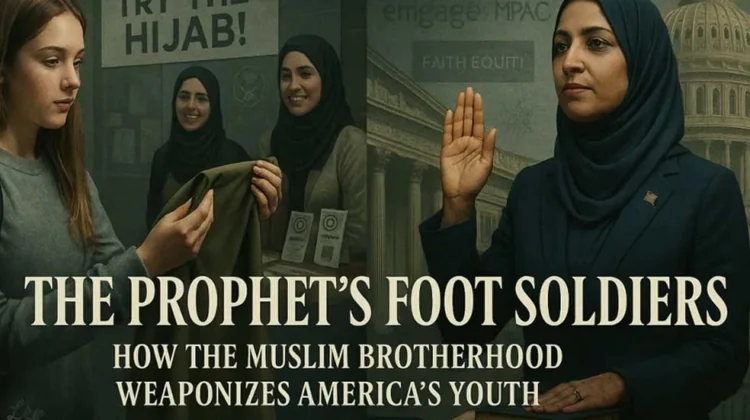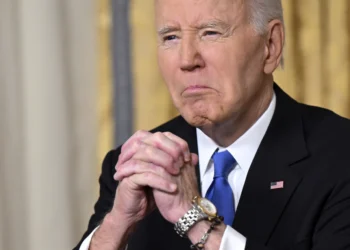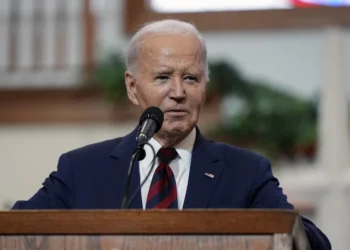
Infiltrate. Influence. Islamize: The Brotherhood’s American Strategy
Not all jihadists look scary and scream Allahu Akbar. Some look great, smile calmly, and speak softly through glowing screens—and they’re being heard.
This is their modern-day jihad. It plays out in American classrooms, youth clubs, and congressional briefings. The mission hasn’t changed—only the medium.
And the soldiers? They look nothing like what we were trained to fear. Today’s warriors for Allah wear designer sneakers and carry ring lights. They speak in soft tones, quote curated lines from the Quran, and smile as they tell your teenager that Islam is the religion Christianity was supposed to be. They headline school panels, show up in Netflix’s teen docuseries, and dominate TikTok and Hulu with carefully packaged ‘faith journeys.
This is marketing with a mission.
The Muslim Brotherhood doesn’t need to smuggle operatives into the United States. They did the work decades ago. What we’re seeing now is the harvest of a long-planted seed: a strategy to neutralize American resistance to Sharia by embedding Islamic ideology in education, politics, culture, and activism. It’s dressed in the language of rights, representation, and peace, but the foundation is jihad.
Make no mistake: they share the same Allah, the same Muhammad, and the same Quran as ISIS and Al-Qaeda. The tone may be different, but the goal remains the same—Islamic domination under Sharia. The weapons are no longer bombs, but badges, books, and microphones.
From hijab booths on college quads to “World Religion Week” in middle schools… from algorithm-approved dawah influencers to Muslim public servants lobbying for “inclusivity” laws that silence criticism of Islam—this is not foreign influence. It’s homegrown. It’s bipartisan. And it’s spreading.
You’re not paranoid. You’re paying attention. This is the result of decades of ideological invasion—marketed as tolerance, funded as equity, and defended as civil rights.
The modern strategy is infiltration through normalization. And no group has mastered that art like the Muslim Brotherhood, whose 1991 internal memo, exposed during the Holy Land Foundation trial, plainly declared:
“The Ikhwan must understand that their work in America is a kind of grand jihad in eliminating and destroying the Western civilization from within and ‘sabotaging’ its miserable house…”
—Muslim Brotherhood, Explanatory Memorandum
Today, that “grand jihad” isn’t being waged with weapons, but with Wi-Fi. The battlefield is your child’s phone. The mission?
Dawah. Conversion. Submission.
One child at a time.
They aren’t hiding in dark corners of the internet. They’re trending. Viral. Followed. Sponsored. And your kids are listening.
Let’s pull back the filter, because behind every aesthetic dawah account is a doctrinal war strategy.
The TikTok Imams and Instagram Hijabis
Social media is the Brotherhood’s new minbar. And America’s youth are the congregation. The mosque isn’t the front line anymore. The “For You” page is.
On TikTok, @muslimthrive (1.2M followers) and @ummjawad (861K) post daily content combining:
- Quran verses
- Hijab tutorials
- Mental health talks
- And gentle criticism of Christianity
Their tone is soft. Their feeds are meticulously staged. Their appeal is massive.
Another account, @convertstories (752K followers), shares daily clips of teens—many from Christian families—publicly declaring the shahada.
The videos often feature tears, subtitles, and affirmations like:
- “I finally found peace.”
- “This is the truth I was always looking for.”
The content doesn’t need to explain Islam. It feels like safety, purpose, and identity. And it spreads—fast.
On Instagram, a new wave of modestly dressed, slickly packaged female influencers are reshaping Islam’s image—one reel, quote, and hijab wrap at a time.
Accounts like @muslimgirl (559K followers), @hijabisecrets (341K), and @nourtagouri (591K) post a blend of:
- Fashion-forward hijab tutorials
- Quran-based affirmations
- “Modesty is power” slogans
- Woke-friendly messages about identity and oppression
Each profile carefully merges Western aesthetics with Islamic devotion—presenting the hijab not as submission, but as liberation.
“The hijab doesn’t oppress me. It protects me.”
—Caption from @hijabisecrets, April 2024
They model the abaya in lighting worthy of Vogue. They quote the Quran with hashtags like #MyChoice and #FeministFaith. And they speak fluently in the language of Western grievance politics: intersectionality, colonialism, microaggressions.
But behind the empowerment narrative is a silent truth: The hijab is not optional in Sharia. These same influencers rarely speak about:
- Honor killings
- Forced marriage
- Child custody laws under Islam
- Or the legal consequences for removing the hijab in the Muslim world
What they do promote is visibility without context, and that’s exactly what makes them powerful.
By 2025, brands such as Sephora, Nike, and H&M had launched full hijab campaigns, often in partnership with the same influencers. Instagram’s algorithm pushed many of them into mainstream fashion feeds, where young girls—Muslim and non-Muslim alike—began to adopt the language of “hijab empowerment” without ever learning what’s behind the fabric.
“Your modesty is your strength.”
—@muslimgirl, sponsored post for H&M Faith Collection, October 2023
Their profiles aren’t just viral—they’re verified. Teen Vogue has run glowing features on hijabi ‘changemakers.’ HuffPost calls them ‘icons of modern modesty.’ And BBC Style lists them among the ‘faces redefining faith in fashion.’
There are no threats. No shouting. Just answers, stories, invitations—and silence from those who should be warning.
The method is patient. The tools are attractive. The target is clear. One account. One message. One declaration at a time.
Preaching in Schools: Where the Brotherhood Walks In
Islamic indoctrination in American schools didn’t arrive with force—it arrived with approval. And more often than not, it enters through the front door, with district funding, smiling administrators, and the language of “inclusion.”
It’s not about religious freedom. It’s about institutional shaping—curriculum, clubs, counselors, and content—all bent toward normalizing Islamic frameworks under the labels of diversity and social-emotional learning.
Start with the Muslim Student Association (MSA). Most school staff treat it like any other student group. But what they rarely know is this:
- The MSA was founded in 1963 by Muslim Brotherhood operatives
- Its foundational teachings were built on the ideologies of Sayyid Qutb and Hassan al-Banna
- Its network extends from Ivy League campuses to high schools and middle schools nationwide
As of 2024, the MSA operates in over 1,500 college and high school campuses across North America.
In 2023, a public school in Fairfax County, Virginia, held an “Interfaith Voices” week. Students were assigned to visit tables from different religions. The MSA booth featured:
- Free Qurans and pro-Palestine flyers
- Hijab wrapping tutorials
- A sign-up sheet for the upcoming “Understanding Islam” club
No counter-view was offered. No opt-out forms were sent home.
The Brotherhood’s reach into American education extends beyond clubs. It’s through teacher training, curriculum consulting, and counselor certification.
At Zaytuna College in Berkeley, co-founded by Hamza Yusuf, students receive formal training in Sharia-based jurisprudence, media strategy, and civic advocacy. Graduates go on to work as:
- DEI consultants
- Public policy advisors
- Religious inclusion specialists
In 2022, a Zaytuna graduate helped write the “Religious Literacy Toolkit” used by school counselors in Portland Public Schools, Oregon. It included guidance like:
“Avoid using the term ‘Islamist’ or discussing radical interpretations. These reinforce Islamophobia.”
—Religious Literacy Toolkit, Portland Schools, 2022
At the center of this web is the Yaqeen Institute for Islamic Research, founded in 2016 by Omar Suleiman in Dallas, Texas.
Suleiman is widely regarded as a voice of modern Islam. He’s led prayers in Congress, spoken at Black Lives Matter protests, and been featured in The New York Times, MSNBC, and The Guardian.
But Yaqeen’s focus isn’t theology. It’s narrative control.
Their content targets three fronts:
- Muslim youth who feel unsure or isolated
- Non-Muslims drawn in by identity politics
- Educators looking for “inclusive” religious content
Yaqeen’s flagship video series includes:
- “Jesus and the Message of Islam”
- “Muslims and Democracy”
- “What Does Islam Say About Women?”
Slick visuals, soft tones, and curated keywords—all designed to shield doctrine behind palatable packaging as tolerant, academic, and compatible with modern Western values.
In 2021, Yaqeen launched its “Conversations” app—a mobile program that supplies pre-loaded replies for young Muslims navigating pushback in classrooms and public life.
Some searchable questions include:
- “Why can’t Muslims leave Islam?”
- “Isn’t Sharia incompatible with U.S. law?”
- “What about LGBTQ Muslims?”
The answers are tactically sanitized:
- Apostasy is reframed as “communal betrayal,” not a capital crime
- Sharia punishments are described as “rare and symbolic.”
- LGBTQ+ issues are redefined as “personal journeys,” not legal violations
This isn’t education. It’s protective messaging, built to neutralize hard questions without revealing doctrinal realities.
The app is promoted through:
- Islamic clubs in public high schools
- MSA chapters on college campuses
- DEI webinars under names like Faith & Identity, Religious Resilience, and Muslim Mental Health in Education
Yaqeen’s Institutional Reach:
They partner with:
- University DEI offices
- Public school administrators
- Nonprofits like MuslimARC, Faithfully Muslim, and ICNA Youth
- YouTube Learning and Google Scholar initiatives
Their teacher workshops include titles like:
- “Countering Islamophobia in the Classroom”
- “Hijab and Female Empowerment”
- “Bridging Culture and Curriculum in Minority Faiths”
The goal: insert Islamic worldviews into public education—without ever calling it Sharia.
At the 2017 ICNA Convention in Baltimore, Omar Suleiman told the crowd:
“We are not here to be accepted—we are here to transform society.”
He meant it.
Yaqeen’s educator materials have been adopted or piloted in at least 12 major school districts, from Texas to Oregon.
And the transformation has already begun—in morning announcements, after-school clubs, diversity audits, and anti-bullying slideshows.
Grooming Girls Through Victimhood
This is the most calculated weapon in the Brotherhood’s arsenal:
The image of the Muslim woman—rebranded.
No longer depicted as oppressed or silenced, she’s now a symbol of resistance, grace, and dignity. A freedom fighter in a hijab.
And the grooming starts young.
One of the most visible campaigns is the #TryTheHijab challenge, organized by WhyIslam and GainPeace—two outreach arms of ICNA (Islamic Circle of North America), an organization with deep ties to the Muslim Brotherhood.
Each year, these groups set up booths at high schools, colleges, and even local fairs. The goal? Encourage girls—Muslim and non-Muslim alike—to try on the hijab as a “symbol of empowerment.”
In 2024, Muslim students at George Mason University distributed free hijabs on campus. Flyers read:
“Experience Empowerment. Dignity. Modesty.”
Students posed for photos with signs that read:
- “My Hijab, My Choice”
- “Covered by Faith, Not by Force”
- “Feminism Includes Us”
Scholars like Dalia Mogahed of Georgetown’s Bridge Initiative often praise these campaigns as ‘essential identity work’—without addressing the global punishments for rejecting the hijab.
The same campaign ran at Rutgers, Duke University, and even state fairs in Minnesota and Michigan—complete with photo booths, social media hashtags, and giveaways.
What wasn’t offered? Any explanation of Sharia, modesty codes, or the legal obligation of hijab in Islamic law.
They don’t tell you what happens if you remove it in Iran, or how girls are beaten for a loose veil in Afghanistan. They skip the fatwas. They skip the courts. They skip the real cost.
Just a scarf. A slogan. And an invitation.
Groups like MPOWER Change, co-founded by Linda Sarsour, elevate the narrative to a form of political warfare.
They reframe Islamic identity as political resistance—using feminism, race, and activism to shield Sharia-based norms from criticism.
At the 2017 ISNA Convention in Illinois, Linda Sarsour told the audience:
“Our number one and top priority is to protect and defend our community. It is not to assimilate and please any other people and authority.”
That’s the doctrine behind the campaign. These aren’t Liberation booths. They’re shield walls—built to silence scrutiny while expanding influence.
Their initiative, “Muslim Women Fight Back,” casts all critiques of Islam as attacks on women’s autonomy. Headlines read:
- “Islamophobia Is Misogyny.”
- “Hijabi Women Are the Frontline of Resistance.”
- “Silencing Muslim Women is White Feminism.”
While they rally on Western stages for justice and respect, they remain silent on:
- Forced marriages
- Honor killings
- Child brides
- The right of Muslim women to leave Islam without punishment
None of it appears in their materials. None of it is mentioned in their schools. But the emotional draw is strong.
Girls aren’t pulled in by doctrine. They’re drawn in by compassion, sisterhood, and the feeling of being seen.
Meanwhile, here’s what Islamic doctrine actually teaches:
“The male is equal to the portion of two females…”
—Quran 4:11
“A woman may not leave the house without her husband’s permission…”
—Reliance of the Traveller, m10.4
“Whoever changes their religion, kill them.”
—Sahih al-Bukhari 9:84:57
“The husband may strike her…”
—Quran 4:34
Under Sharia, a woman’s:
- Testimony is worth half that of a man
- Inheritance is less than a man’s
- The right to choose her own spouse can be overridden
- Freedom to remove her hijab is legally restricted or criminalized in many Islamic countries
None of this is taught at the hijab booth. The scarf is handed out with a smile, and the ideology grows with it. By the time the girl shares her selfie with #MyHijabMyChoice, she’s not just wearing fabric; she’s wearing a symbol.
Not of faith, but of ideological submission dressed as self-expression.
From the Mosque to the Hill: Who’s Fueling the Pipeline?
Follow the money. Because this isn’t just social media grooming—it’s funded, protected, and politically armored.
For every hashtag and hijab booth, there’s a network of nonprofits, grant pipelines, and strategic alliances turning Islamic ideological expansion into a taxpayer-backed infrastructure project.
Start with Islamic Relief USA, headquartered in Alexandria, Virginia.
It presents itself as a humanitarian aid group, but receives millions in federal funding through programs for refugee resettlement, disaster relief, and community development.
What’s never discussed on grant forms?
- Islamic Relief USA is a branch of Islamic Relief Worldwide, which the UAE and Israel have banned for its alleged connections to the Muslim Brotherhood and Hamas-affiliated operatives.
- In 2014, the Israeli Ministry of Foreign Affairs designated Islamic Relief as having ties to terror financing.
- In 2020, Germany’s federal interior ministry investigated its links to Islamist groups.
Yet here in the U.S., it received over $1.6 million in federal funds in 2022 alone—much of it through USAID and FEMA.
Then there’s MPAC—the Muslim Public Affairs Council, based in Los Angeles. It doesn’t run schools or preach sermons. It runs policy briefings, legislative guides, and closed-door meetings on Capitol Hill.
MPAC’s talking points often mirror those of the Brotherhood:
- Expand “religious accommodation” policies
- Push for speech codes that penalize “Islamophobia”
- Normalize the use of Islamic chaplains in schools, hospitals, and prisons
Their 2023 policy memo called for:
“Expanded federal recognition of religious justice frameworks, including the integration of religious law perspectives in DEI programs.”
In plain English: Legal carveouts for Sharia-compliant behavior under the guise of “faith equity.”
Meanwhile, new groups like Emgage, Muslims for Social Justice, and Jetpac are working to seed Islamic political power at every level—from school board races to Senate campaigns.
Their strategy isn’t conversion. It’s legislation.
They fund, endorse, and platform candidates who:
- Support Islamic advocacy inside public education
- Defend foreign Islamic governments from criticism
- Advocate for religious exemptions that align with Sharia frameworks
Among their most visible beneficiaries:
Ilhan Omar, Rashida Tlaib, and Andre Carson—all of whom have:
- Spoken at Brotherhood-linked events
- Partnered with Emgage and MPAC
- Campaigned alongside figures and organizations flagged for Islamist ties abroad
In 2021, Emgage openly praised Tlaib for “centering Palestinian and Muslim voices in American lawmaking.”
In 2022, Jetpac trained over 80 Muslim candidates for local office with courses titled “Faith-Based Leadership” and “Power Mapping for Minority Governance.”
The same nonprofits that lobby for legislation also fund campus clubs, sponsor influencer campaigns, and pay for digital dawah promotion.
- In 2021, Islamic Relief USA partnered with @muslimgirl for a Ramadan campaign on “faith and justice”—reaching over 500,000 users.
- MPAC and Emgage routinely co-sponsor livestreamed panels with Muslim influencers on topics like “Islam and mental health,” “Faith in politics,” and “Reframing Muslim identity in America.”
- GainPeace and ICNA Relief offer grants to Muslim Student Associations that host hijab booths, convert-friendly events, and public dawah tables.
- Emgage PAC has donated to candidates who appear alongside social media influencers as part of their faith-outreach strategy.
The grooming isn’t just social. It’s strategic. They raise the voices—then fund the laws that protect them.
What You Call Diversity—They Call Dawah
This isn’t a story of peaceful coexistence. This is conquest by cultivation. This is dawah disguised as diversity.
The Muslim Brotherhood isn’t knocking on your door. They’re already on your kid’s phone. Already in their school club. Already liked, followed, and saved in a story.
One video. One lesson. One confused kid at a time.
Let’s be clear:
They’re not winning because they’re brilliant. They’re winning because too many on our side… stopped watching.
Because too many Christian parents handed over iPads—and forgot to hand over Scripture. Because the church went quiet while TikTok turned up the volume. Because the Brotherhood got donors while truth-tellers got defunded.
This didn’t happen in secret. It happened in broad daylight, while we scrolled past it.
So if you want to stop it, don’t just blame the Brotherhood. Start guarding your house. Start discipling your children.
Start naming what’s evil—even if it sounds “inclusive.”
Because there is no middle ground between Jesus Christ and Sharia. Only one leads to life.
The other rewrites everything, including your child’s soul.

















